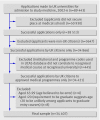Widening access to medical education for under-represented socioeconomic groups: population based cross sectional analysis of UK data, 2002-6
- PMID: 21343208
- PMCID: PMC3043108
- DOI: 10.1136/bmj.d918
Widening access to medical education for under-represented socioeconomic groups: population based cross sectional analysis of UK data, 2002-6
Abstract
Objective: To determine whether new programmes developed to widen access to medicine in the United Kingdom have produced more diverse student populations.
Design: Population based cross sectional analysis.
Setting: 31 UK universities that offer medical degrees.
Participants: 34,407 UK medical students admitted to university in 2002-6.
Main outcome measures: Age, sex, socioeconomic status, and ethnicity of students admitted to traditional courses and newer courses (graduate entry courses (GEC) and foundation) designed to widen access and increase diversity.
Results: The demographics of students admitted to foundation courses were markedly different from traditional, graduate entry, and pre-medical courses. They were less likely to be white and to define their background as higher managerial and professional. Students on the graduate entry programme were older than students on traditional courses (25.5 v 19.2 years) and more likely to be white (odds ratio 3.74, 95% confidence interval 3.27 to 4.28; P<0.001) than those on traditional courses, but there was no difference in the ratio of men. Students on traditional courses at newer schools were significantly older by an average of 2.53 (2.41 to 2.65; P<0.001) years, more likely to be white (1.55, 1.41 to 1.71; P<0.001), and significantly less likely to have higher managerial and professional backgrounds than those at established schools (0.67, 0.61 to 0.73; P<0.001). There were marked differences in demographics across individual established schools offering both graduate entry and traditional courses.
Conclusions: The graduate entry programmes do not seem to have led to significant changes to the socioeconomic profile of the UK medical student population. Foundation programmes have increased the proportion of students from under-represented groups but numbers entering these courses are small.
Conflict of interest statement
Competing interests: All authors have completed the Unified Competing Interest form at
Figures
Comment in
-
Widening access to medical school. Access schemes are not enough.BMJ. 2011 Mar 29;342:d1941. doi: 10.1136/bmj.d1941. BMJ. 2011. PMID: 21447573 No abstract available.
References
-
- Cohen, J. The consequences of premature abandonment of affirmative action in medical school admissions. JAMA 2003;289:1143-9. - PubMed
-
- British Medical Association. The demography of medical schools: a discussion paper. BMA, 2004.
-
- James D, Ferguson E, Powis D, Symonds I, Yates J. Graduate entry to medicine: widening academic and socio-demographic access. Med Educ 2008;42:294-300. - PubMed
-
- Cohen J, Steinecke A. Building a diverse physician workforce. JAMA 2006;296:1135-7. - PubMed
-
- Saha S, Guiton G, Wimmers PF, Wilkerson L. Student body racial and ethnic composition and diversity-related outcomes in US medical school. JAMA 2008;300:1203-5. - PubMed
Publication types
MeSH terms
LinkOut - more resources
Full Text Sources

